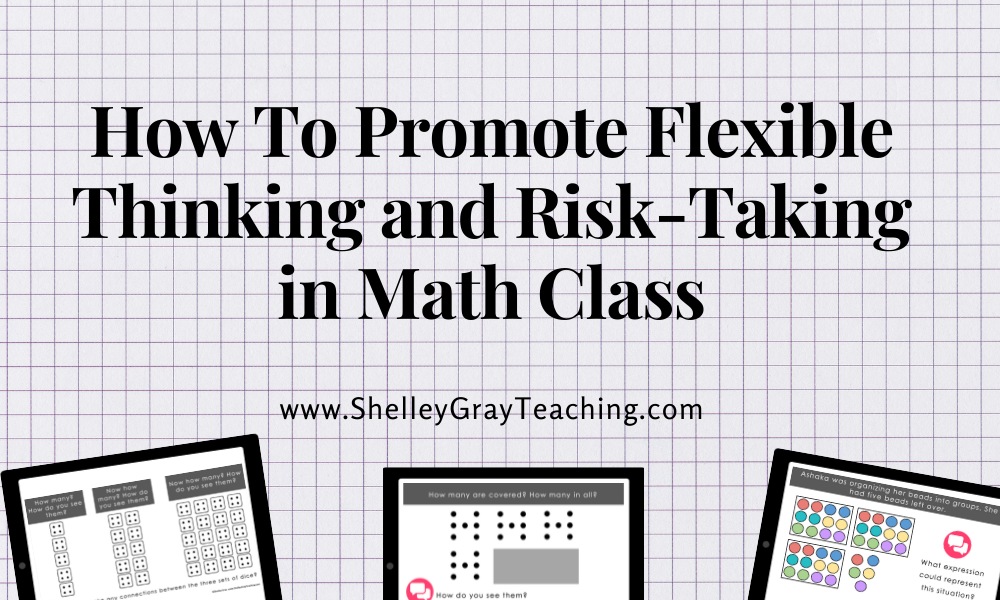
Showing students that math is a flexible subject can be powerful. So many kids (and adults) believe that math is all about getting right answers. But it’s not! When we can show students that there are many ways to solve a problem and that we can use flexible thinking to think in different ways, we empower our students.
We allow them to see math as a creative subject and give them the opportunity to see math in their own way.
In this post, Shareen Hando, a teacher from Winnipeg, Manitoba, shares the many different ways she uses Math Conversations in her classroom to empower her students – helping them to see themselves as mathematicians and share their thinking in creative ways.
My Math Background
I come from a background of experiencing math anxiety, timed tests, and focusing on mental math and fluency rather than problem-solving – I share this commonality with many colleagues. Because of my past experience, I was passionate about finding methods and research-based practices to build mathematical mindsets and problem-solving practices with my students, and sharing math ideas in creative ways.
Related: 13 Simple and Quick Alternatives to Timed Math Fact Tests
Encouraging Risk-Taking, Flexible Thinking, and Confidence with Problem-Solving
I started the year with an emphasis on, and celebration of, every student’s ideas – correct or not. As part of our daily number routine, reluctant sharers knew that every morning, every student had an opportunity to share. They could see that other students might have made a mistake, but those students were recognized for trying and explaining their reasoning.
The focus was not on the right answer, but instead on the thinking and the courage to try.
Constant daily exposure helped students begin taking risks and feel comfortable sharing ideas without the pressure of the teacher calling on them. My goal was for students to feel comfortable sharing and to respond with a comment or question that kept students thinking. Slowly but surely, I began to hear the discourse in my classroom with phrases like
“I’d like to add on to…”
“I agree because…”
“I like how you solved it.”
“I disagree. How about…”
I began seeing math talk signals being used in other subjects and the phrases we use during play.
Resources that Help Me Promote Flexible Thinking and Risk-Taking in Mathematics
I found Shelley Gray resources during a time of hybrid learning. Teaching both in-person and online was already a near-impossible task – throw in creating engaging digital and paper activities and it was, well… is there a word for worse than impossible? There were not enough hours in the day.
In this digital space we have so many amazing websites to find tasks such as counting collection images, which one doesn’t belong (WODB), subitizing images, and story problems – but wouldn’t it be nice to have ALL of these diverse rich tasks in one place, catered to your students’ ability levels?
I aligned immediately with the philosophy and ideas that Shelley incorporates into her resources. I jumped right in, and both students and I LOVED her Math Conversations. The next year, I began exploring different ways I could incorporate Math Conversations into my combined classroom.
How I Adapt and Use Math Conversations in My Classroom
Math Warm-Ups
We pull up a math conversation slide and right after the morning meeting my students are ready for a minds-on thinking task. We establish our math talk symbols, reinforce that mistakes help us grow and we are off!
Related: Do You Need Help With Number Talks? Here’s the Quick Start Guide

Activating Prior Knowledge Before Introducing a New Concept
If we are starting a new unit, I will scroll to find a Which One Doesn’t Belong (WODB) to spark curiosity and activate what students already know.

Sharing Ideas for In-Person and Online Learners Via Flipgrid
Work smarter, not harder as my colleagues would say! I was able to have rich conversations with students during hybrid learning by posting a slide of the Math Conversations through Flipgrid. In class, we would have a whole class math talk, and then share student responses on Flipgrid; online learners were able to add their own ideas to the same math conversation, and view their friends’ responses afterwards! It was so powerful! It made my students feel connected, and they felt like they had a responsibility to share and teach their friends at home.
Displaying Math Tasks and Student Thinking in the Classroom
Recently, I have started making 4-5 monthly math tasks that center around concepts and goals we are focusing on in numeracy. I pulled slides from Shelley’s Math Conversations to showcase and display students’ learning. We started with projecting the slide on the screen, then I would record students’ thinking with their initials and have a math talk.
Students love seeing their work on the board! If students agreed, I would also add their initials beside one solution.


I also used the Math Conversation slides to create bulletin board displays where students could share their flexible thinking. I love displaying students’ thinking because even those who are more reluctant to publicly share are still given a chance to write down their answers to the math task. They are given a choice if they want to write their name on the back or front of the card.





Math Conversations have been a huge hit in our classroom. During our math instruction, it has been amazing to see students reflect back on our bulletin board and make connections when we are practicing skills such as two-digit addition or equality. Showing students’ thinking allows them to feel not only more confident in sharing ideas, but also to see themselves as mathematicians.
Ready to Start Math Conversations to Foster Strategic, Flexible Thinking in Your Classroom?
Each Math Conversations package includes 200 ready-made slides. There is NO prep required – just display the slide and start your math talk! See all the details HERE.










